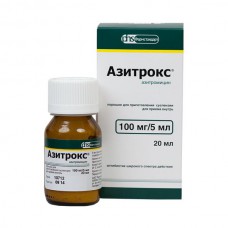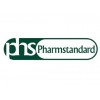Expiration date: 02/2025
Form release
Powder for preparing an oral suspension 100mg/5ml, 200mg/5 ml
Composition
1 bottle contains:
Azithromycin dihydrate, in terms of azithromycin 400mg, 800 mg,
excipients: Sucrose (sugar), Sodium carbonate (sodium places were anhydrous), xanthan Gum (xanthan gum), Hyprolose (Klucel EF), Flavouring "Banana", "cherry", "Vanilla".
Packaging
On 15.9 g in bottles with a capacity of 50 ml of dark (amber) glass. One bottle, together with the instructions for use, a measuring spoon and a pipette for dosing, are placed in a pack of cardboard.
Pharmacological action
Azitroks – bacteriostatic broad-spectrum antibiotic from the macrolides-azalides. It has a wide range of antimicrobial action. The mechanism of action of azithromycin is associated with the suppression of microbial cell protein synthesis. Binding to 50S-subunit of ribosomes, inhibits peptidtranslokazu being broadcast and suppresses protein synthesis, slowing the growth and reproduction of bacteria. In high concentrations has a bactericidal effect.
It has activity against a number of gram-positive, gram-negative, anaerobic, intracellular and other microorganisms.
Sensitive microorganisms: aerobic gram-positive microorganisms-Staphylococcus aureus (methicillin-sensitive strains), Streptococcus pneumoniae (penicillin-sensitive strains), Streptococcus pyogenes, Streptococcus spp. (group C, F and G), aerobic gram-negative microorganisms-Haemophilus influenzae, Haemophilus parainfluenzae, Legionella pneumophila, Moraxella catarrhalis, Pasteurella multocida, Neisseria gonorrhoeae, anaerobic microorganisms-Clostridium perfringens, Fusobacterium spp., Prevotella spp., Porphyriomonas spp., other microorganisms-Chlamydia trachomatis, Chlamydia pneumoniae, Chlamydia psittaci, Mycoplasma pneumoniae, Mycoplasma hominis, Borrelia burgdorferi.
Microorganisms with acquired resistance to azithromycin: aerobic gram - positive microorganisms-Streptococcus pneumoniae (penicillin-resistant strains and strains with medium sensitivity to penicillin).
Microorganisms with natural resistance to azithromycin: aerobic gram – positive microorganisms - Enterococcus faecalis, Staphylococcus aureus (methicillin-resistant strains), Staphylococcus epidermidis (methicillin-resistant strains), anaerobic microorganisms-Bacteroides fragilis.
Described cases of cross-resistance in Streptococcus pneumoniae, Streptococcus pyogenes (beta-hemolytic group a Streptococcus), Enterococcus faecalis and Staphylococcus aureus (including methicillin) to erythromycin, other macrolides, and azithromycin lincosamides.
Indications
Infectious and inflammatory diseases caused by microorganisms sensitive to azithromycin, including:
- upper respiratory tract and ENT organs including pharyngitis/ tonsillitis, sinusitis, otitis media,
- lower respiratory tract, including acute bronchitis, exacerbation of chronic bronchitis and community-acquired pneumonia,
- genitourinary tract infections caused by Chlamydia trachomatis (urethritis, cervicitis),
- infections of the skin and soft tissues (acne ordinary (acne) of moderate severity, erysipelas, impetigo, secondary infected dermatoses),
- Lyme disease-the initial stage (migrating erythema - erythema migrans).
Contraindications
Hypersensitivity to azithromycin, other macrolides or other components of the drug, impaired liver function severe (no data on efficacy and safety), impaired renal function (CC less than 40 ml/min (no data on efficacy and safety)), sucrose/isomaltase deficiency, fructose intolerance, glucose-galactose malabsorption, children under 6 months of age, breastfeeding, simultaneous administration of ergotamine and dihydroergotamine.
Caution: moderate hepatic impairment, impaired renal function (QC over 40 ml/min), predisposition to arrhythmias and prolongation of QT interval, combined with antiarrhythmic means class IA, III, cizapridom, in the presence of hypokalemia or hypomagnesemia, clinically significant bradycardia, arrhythmia or severe heart failure, concurrent use of terfenadine, warfarin, digoxin, pregnancy, myasthenia gravis, diabetes mellitus.
Application during pregnancy and breast-feeding
Azithromycin is used during pregnancy only if the intended benefit to the mother exceeds the possible risk to the fetus. Breastfeeding should be suspended for the duration of azithromycin therapy.
Method of application and doses
Azitrox should be taken orally, 1 hour before or 2 hours after meals once a day.
For the preparation of suspension in a vial with powder to add water (distilled or boiled and cooled) in the amount of 9, 5 ml. Water measure with a pipette for dispensing attached to the bottle. The contents of the vial thoroughly shaken to obtain a homogeneous suspension. The actual volume of the prepared suspension will be 20 ml.
Store the prepared suspension in the original package for no more than 5 days at a temperature not exceeding 25 °C. do not freeze.
Before each use, the suspension must be shaken. For dosing of the finished suspension, a pipette for dosing or a measuring spoon is used. Immediately after taking the suspension, it is necessary to drink a few SIPS of water to rinse and swallow the drug remaining in the oral cavity. After using a measuring spoon or dropper, which is pre-disassembled, washed in running water, dried and stored together with the drug.
For infections of the upper and lower respiratory tract, ENT organs, skin and soft tissues (except for migratory erythema): at the rate of 10 mg/kg body weight 1 time per day for 3 days (course dose 30 mg/kg).
Children older than 6 months weighing up to 10 kg are advised to take the drug in the form of a powder for the preparation of an oral suspension with a concentration of 100 mg / 5 ml.
Adults-500 mg 1 time per day for 3 days (course dose – 1, 5 g).
In the treatment of the initial stage of Lyme disease (migratory erythema – erythema migrans): once a day: on the 1st day-at a dose of 20 mg/kg body weight, then from the 2nd to the 5th day at a dose of 10 mg/kg body weight. Course dose – 60 mg/kg of body weight.
Adults-1, 0 g on the first day, then 500 mg/day daily from 2 to 5 day (course dose 3, 0 g).
Infections of the genitourinary tract caused by Chlamydia trachomatis( urethritis, cervicitis): in uncomplicated urethritis – cervicitis-adults once 1, 0 g -25 ml of the suspension 200 mg / 5 ml.
In the treatment of acne (acne ordinary) moderate: in 1, 2 and 3 day of treatment take 500 mg (12, 5 mg 200 mg / 5 ml suspensions) 1 time a day, then take a break from the fourth to seventh day, from the eighth day of treatment take 500 mg 1 time a week for 9 weeks (course dose 6, 0 g).
Side effect
Side system blood and lymphatic system: often – lymphocytopenia, eosinophilia, rarely – leukopenia, neutropenia, rarely thrombocytopenia, hemolytic anemia.
From the nervous system: often – dizziness, headache, paresthesia, anorexia, infrequently – nervousness, hyposthesia, insomnia, drowsiness, rarely – agitation, very rarely – fainting, convulsions, psychomotor hyperactivity, exacerbation of myasthenia gravis, anxiety, aggression.
From the sensory organs: often – hearing loss, decreased visual acuity, impaired perception of taste sensations, rarely – tinnitus, deafness, rare - vertigo; very rarely anosmia, loss of taste, parosmia.
From the side of cardiovascular system: rarely – palpitations; very rarely arrhythmia, ventricular tachycardia, increased QT interval, arrhythmia type "pirouette", a decrease in blood pressure.
From the digestive system: very often-nausea, diarrhea, abdominal pain, flatulence, frequent vomiting, dyspepsia, infrequently – gastritis, constipation, very rarely – changing the color of the tongue, pseudomembranous colitis, pancreatitis.
From the liver and biliary tract: infrequently – hepatitis, increased activity of "hepatic" transaminases, hyperbilirubinemia, rarely – impaired liver function, very rarely – cholestatic jaundice, liver failure, fulminant hepatitis, liver necrosis.
Allergic reactions: often-itching, rash, infrequently-angioed edema, hypersensitivity reactions, Stevens-Johnson syndrome, photosensitization, CRA-pivnitsa, very rarely – anaphylactic reactions, toxic epidermal necrosis, multiform erythema.
From the side of musculoskeletal system: often – arthralgia.
From the urinary system: rarely - increased concentration of urea and creatinine in blood plasma; very rarely interstitial nephritis, acute renal failure.
Other: often – fatigue, rarely, chest pain, peripheral edema, pain, asthenia, vaginitis, candidiasis of different localization.
Special instruction
When assigning patients with diabetes mellitus, as well as with low-calorie diet must be considered that the composition of the slurry includes sucrose (3, 7 g/5 ml or 0, 3 HYE/5 ml).
In the case of missing one dose of the drug - the missed dose should be taken as soon as possible, and the following - at intervals of 24 hours.it is Necessary to observe the recommended scheme in the instructions and the duration of the drug.
Azithromycin is contraindicated in patients with severe liver dysfunction. Patients with moderate hepatic impairment azithromycin should be administered with caution due to the possibility of fulminant hepatitis and severe liver failure. In the presence of symptoms of liver dysfunction (rapidly increasing asthenia, jaundice, darkening of urine, bleeding tendency, hepatic encephalopathy), azithromycin therapy should be discontinued and a study of the functional state of the liver should be conducted.
With moderate renal failure (CC more than 40 ml/min) azithromycin should be administered under the control of kidney function.
There is no evidence of possible interaction between azithromycin and ergo-Tamin and dihydroergotamine derivatives, but due to the development of ergotism while taking macrolides with ergotamine and dihydroergotamine derivatives, this combination is contraindicated.
With prolonged intake of azithromycin, pseudomembranous colitis caused by Clostridium difficult may develop, both in the form of mild diarrhea and severe colitis. With the development of diarrhea on the background of taking azithromycin, as well as 2 months after the end of therapy, clostridial pseudomembranous colitis should be excluded.
With delayed ventricular repolarization syndrome - Qt prolongation syndrome - against the backdrop of macrolides, including azithromycin, the risk of arrhythmia development increases. Caution in the appointment of azithromycin should be observed in patients with prolonged QT interval receiving anti-arrhythmic therapy means of classes IA, III, cizapridom, in the presence of hypokalemia or hypomagnesemia, clinically significant bradycardia, arrhythmia or severe heart failure.
The use of azithromycin can provoke the development of myasthenic syndrome or exacerbate myasthenia gravis.
Since 2010, azithromycin has been recommended by the international Union for the control of sexually transmitted infections, in collaboration with who / Europe, as the first choice drug for treating chlamydial infection during pregnancy.
As the use of other antibiotics, during therapy with azithromycin should regularly assess patients for the presence of immune microorganisms and indications for the development of superinfection, including fungal.
Overdose
When taking high doses of the drug may be observed increase dose-dependent side effects: temporary hearing loss, severe nausea, vomiting, diarrhea.
Treatment: the appointment of activated charcoal, symptomatic therapy, control of vital functions.
Storage conditions
Keep out of reach of children at temperature not exceeding 25 °C.
Store the prepared suspension at a temperature not exceeding 25 ° C. do not freeze.
Shelf life
2 years. Prepared suspension-no more than 5 days.



